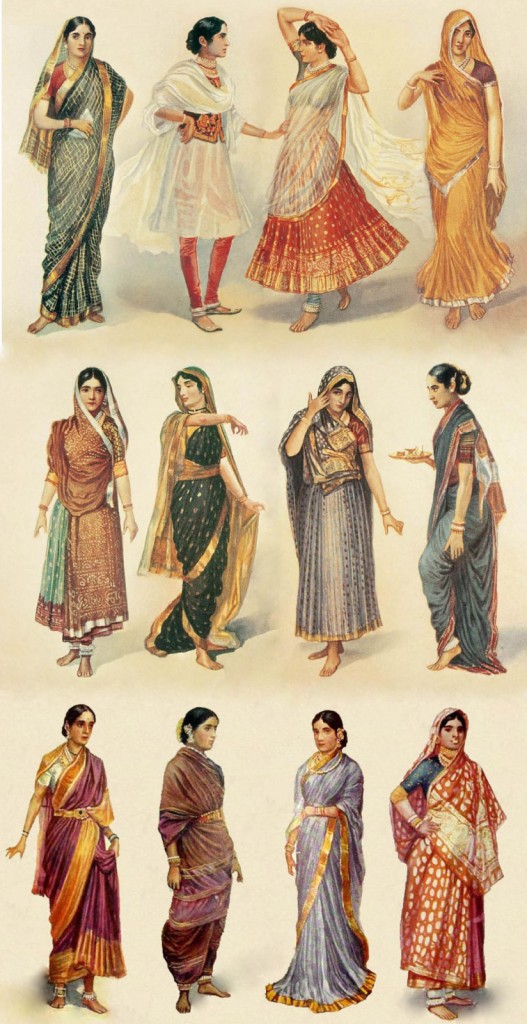In India, we have few types of clothes. They are easy to remember and identify, since they are the jeans, shirts, skirts, and tank tops of India. The tricky part is identifying the region of the material. Every state and even smaller regions have their own particular handwork done with the sari. The colors, the use of mirrors or gold, the size of the border, all show off a community’s hard work.
Sari – It is from 4 to 9 yards and can be made from any fabric. Most common fabrics are cotton and silk because of the breathable quality and ability to keep women cool during the summer.
The sari is usually worn over a petticoat (called lehenga, pavada, or chaniyo) with a blouse known as a choli. The choli has short sleeves and a low neck and is usually cropped. Cholis may be backless, short or long length, or short or long sleeved.
The sari is draped over the shoulder (right or left) and the paloo, the most decorated part, appears after the shoulder.
Women wear saris as daily wear. I have always seen my grandmothers wear saris (occasionally salwar kameez) no matter the weather or event. Simple saris can be made from cotton to machine spun silk. Wedding and party saris can have zari (gold stitching), beadwork, stampwork, to embellish the material.
The many different ways of wearing a sari

Salwar kameez – The India salwar kameez is easy everyday wear for women. It is formed a long top with or without sleeves and has pants. The pants can be tight or loose depending on the style. A dupatta, a simple light scarf, is worn with the outfit. The entymology of kameez comes from the Arabic word, qamis, a shirt. The word ‘salwar’ has its roots in Persian (Farsi) and it means pants.
Chenia choli – Also known as the lengha choli or ghagra choli. The lengha is the decorated skirt that is heavily embroidered or with mirrors and patchwork. The short top is called the choli. The choli usually falls below the bust and has short sleeves. A ligher piece of cloth, called the odhani, is folded over the shoulder. Gujarati and Rajasthani women will fold the odhani over the right shoulder and to the front, showing off the material.
Lenghas are popular today as wedding gown wear for brides. A heavy embroidered panetar for Gujaratis or unusual colors (pink, green, blue) are hot choices today.
Two lengha styles – Left, a gujarati chenia choli with bandhani, abla, and kutch border. Right, an embroidered, wedding lengha
 1. Chenia Choli in Stockholm, 2. Akshie wedding
1. Chenia Choli in Stockholm, 2. Akshie wedding
Men’s outfits in India
Kurta – The kurta pajama is a simple long top and pants worn by men. They are similar to the women’s salwar kameez. The kurta is found in more muted colors (whites, ivory, beige, tan) with light embroidery around the collar, cuffs, and button down. It’s a great piece to be Indian and casual.
Sherwani – The sherwani is a royal kurta pajama set. It was originally worn in British India first by the royalty and then the upper classes. In Pakistan, it is the national dress for men and is often worn by the elite. Sherwani have intricate embroidery with beads and gems and are available in a variety of heavy silks and of course plenty of colors. Today, men wear sherwanis for weddings as they are like the tuxedo of India.
The groom on the right is wearing a sherwani

Dhoti – The dhoti is a very traditional indian outfit worn mainly by priests. Some bridegrooms will wear a dhoti for the wedding but guests do not usually wear one unless it is common practice in the community.
The men in the bottom row are wearing dhotis. They are big and pouffy. These men bought the material and had it ready stitched, that way you only need to string up and tie it.


i wore a kurta once! it was beige. but how do i get one of those sherwani?? those coats look amazing!!
@Initials MB You can buy sherwanis from here http://www.rajasthanistore.com one of the best online store for all kinds of beautiful sherwanis I have ever seen.
Great run-down guide of the types of clothing worn in an Indian wedding!